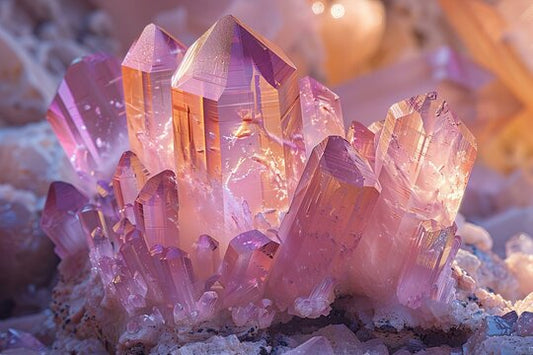
D is for Dendritic Agate
Natalie IfillWith A, B and C, done and dusted it's time to explore something a bit more unusual. D is for Dendritic Agate, a beautiful translucent stone known for its characteristic veins resembling branches of a tree.
Dendritic Agate is otherwise known as Tree Agate due to these inclusions. Its name stems from the Greek word “Dendron” meaning tree. Another name it's referred to is the “Stone of Plentitude”, this name refers to its core meaning and purpose. Many people believe this stone meaning is connecting to abundance in all parts of life. This belief dates back to Ancient Greece, where people would use this stone to achieve better harvests. It became a common practice during this time for people to bury Dendritic Agates in their fields before sowing to get good crops. They would also associate Dendritic Agate with tree spirits, woodlands and dryads.

So how long has Dendritic Agate been around?
As always pinning down a specific date seems to be an impossible task however, Dendritic Agate has been used for many years, both as medicinal aid and decorative elements in jewellery, etc. We can trace Dendritic Agate back to the Neolithic Period. There are also traces of Dendritic Agate being in artefacts such as ornaments and amulets found in Babylon during the Bronze Age.
This stone regained popularity due to Carl Fabergé (1885-1916), the silversmith of the Imperial Court in Russia, frequently using this stone in his creations. People in Russia also came to love this stone due to its connections to longevity, good health and prosperity.
Dendritic Agate is a part of the agate family (hence the name). Agates are an extremely common rock formation, consisting of both chalcedony and quartz as their primary elements. Dendritic Agate’s name is a bit of a misnomer, Agates are generally classified as a microcrystalline form of quartz with specimens showcasing bands of alternating colours, whereas Dendritic Agate does not contain these bands but instead very beautiful fissures. Dendritic Agate is closer to a Chalcedony in its make up which is also a crystalline structure, however, it consists of a fibrous crystalline structure. Chalcedony’s tend to appear milk, translucent or opaque.
Dendritic agates form when water, rich in manganese and iron oxides, flows through fissures and cracks in rocks/minerals. Sometimes, this water can seep into the three-dimensional crystal structure and develop incredibly detailed formations. As water containing these oxides enters the crystal structure the black/brown particles of manganese/iron are left behind. The unique branch patterns require millions of years to be formed and only the right conditions allow the solidification and crystallisation of the particle.
Where is Dendritic Agate found?
Most Dendritic agates tend to be found in Brazil, however other deposits include India, Iceland, Mexico, the USA, Kazakhstan and Madagascar.
5 fun facts about Dendritic Agate:
- It has been associated with the Roman plant goddess Flora, and the hunting goddess, Artemis. Symbolising nature and the forest.
- It was used medicinally through Ancient Greek and Egyptian civilisations, spreading throughout Africa, the Middle East and even Russia. Today people believe Dendritic Agate has numerous health benefits from helping blood flow to treating skeletal problems to providing pain relief
- It is a difficult stone to cut due to its inclusions occurring at various depths within the rough stone. To expose the most unique and interesting patterns, the lapidary artists have to cut the material of the stone in precisely the right way. This increases the rarity of the stone and can make it more expensive.
- In India, this stone is referred to as the Mocha Stone due to formerly being transported from the Arabian Harbour of Mocha
- Many people believe this stone can help you create a strong link with earth, and assist with protecting your place in the universe.
If you enjoyed this post, check out the rest in our series: A-Z Gemstone's Uncovered.
We'd love to hear your thoughts, what's your favourite thing about Dendritic Agate or which gemstone would you like us to feature next! Comment below, like or share this post.










